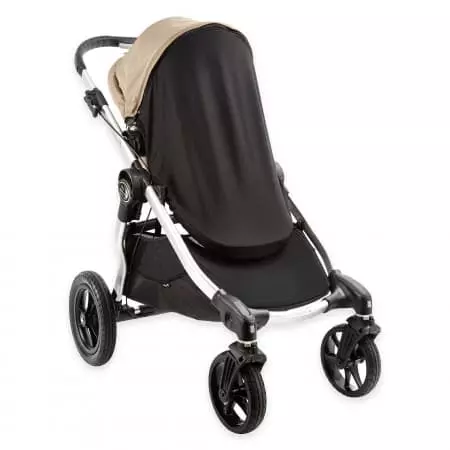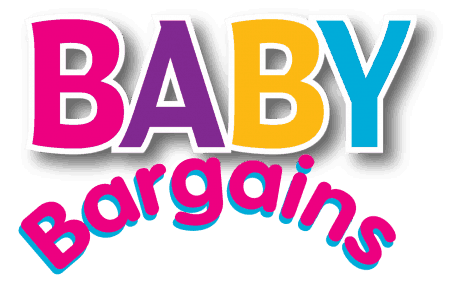Best Lightweight Stroller 2024
We waded through 74 lightweight strollers—folding, unfolding, buckling, un-buckling—until we found the very Best Lightweight Stroller 2024: the Baby Jogger City Mini 2.
Lightweight strollers are the holy grail of the stroller market—enough convenience features (easy fold, cup holder) for parents and comfort (canopy, seat pad) for baby, but not too much to add unnecessary weight. We generally define “lightweight” as strollers under 20 lbs. empty (not including baby!). Our pick in this category is the Baby Jogger City Mini 2, an excellent tri-wheel stroller with oversized canopy and fully reclining seat.
Baby Jogger’s quick fold technology is amazing—you lift a strap in the middle of the stroller and zip! It’s folded. An optional car seat adapter can turn a City Mini 2 into a travel system if you wish. As a brand, Baby Jogger has a good reputation for quality. Now owned by Graco, Baby Jogger got its start by making (you guessed it) jogging strollers in the 80’s. After going through a bankruptcy and ownership change in the early 2000’s, the company pivoted to making easy-to-fold strollers in both the lightweight and multi-function markets. Scroll down for more details on the City Mini 2.
More details on the Baby Jogger City Mini 2
The tri-wheel City Mini 2 (single, 17.1 lbs.; double, 26.6 lbs.) is Baby Jogger’s best-selling stroller, featuring a full recline and large canopy. In a recent refresh,
Here’s what’s new with the City Mini 2: an adjustable footrest (when raised, it provides front access to the storage basket), standing fold (yeah!) and included car seat adapters for Baby Jogger and Graco car seats. Those adapters used to be an extra twenty bucks. Also new: adapters for the Clek Liing and UPPAbaby Mesa car seats (coming later in 2019).
As you’d image, Baby Jogger also updated the City Mini 2’s fashion and styling. The canopy is more sleek and adds a bit more coverage.
The City Mini 2’s fashion is toned down to reflect current trends: light grey, dark grey and a really dark grey. Besides a blue-ish gray (Slate), gone are the bright jewel tones of the original City Mini.
Unfortunately, the price has also gone up too.
Overall, this is much-needed refresh for a stroller that, while a best-seller, had not been updated since 2008.
The secret sauce to the City Mini Series is the company’s Quick-Fold technology: pull up on one strap and zip! The stroller collapses and folds. No complicated buttons or latches. No multi-step process. The Quick-Fold has super-sized Baby Jogger’s sales in recent years and other stroller makers have rushed to copy it.
We should note that Baby Jogger sells car seat adapters (most are under fifty bucks) for the City Mini that fit most major brands of car seats. This is one advantage the City Mini has over our other umbrella (lightweight) stroller picks—it can accommodate an infant car seat. You can buy the car seat adapter direct from Baby Jogger or online.
Baby Jogger also makes a raft of accessories for the City Mini: everything from weather shields to glider boards (for older toddlers to stand on), as well as a foot muff, cup holders and parent consoles. That’s the advantage of going with a brand like Baby Jogger. Less expensive lightweight stroller brands typically have few (or no) accessories.
FYI: We should mention that Baby Jogger also has various spin-offs of the City Mini, including the newer City Tour 2 (a four-wheeled version with more compact fold) and the City Mini GT 2 (with more rugged wheels).
Best Budget-Friendly Lightweight Stroller. Kolcraft’s entry-level strollers are winners. Dollar for dollar, these are the best affordable strollers on the market. Compared to other low-end brands (Graco, Cosco), Kolcraft shines. The entry-level offering is the Cloud Plus.
In our testing, the Kolcraft Cloud strollers came out on top in the budget-friendly category—parents tell us they are a good value for the dollar, praising the simple fold and extended canopy (something often missing in this price category).
Best Lightweight Stroller For City Dwellers (Winter). If you live in the city, you need a stroller that can navigate winter slush, snow and other non-weather city hazards (rough sidewalks). Our pick for these folks, the the Baby Jogger City Mini GT 2 (21.5 lbs.), is similar to the base City Mini 2 but adds bigger, no-flat tires, as well as an adjustable handle bar with brake, a redesigned seat/canopy that provides more headroom, and an easier to access storage basket.
At 21.5 lbs., the City Mini GT pushes the outer limits of what we consider lightweight. But that’s the trade-off for the bigger wheels, which add about four pounds over the basic City Mini.
Also: Baby Jogger has a raft of winter accessories, like a foot muff (for baby) and hand muff (for parents). As you can see, this stroller can battle whatever Mother Nature can dish out, in our opinion.
Based on our testing and parent feedback, we pick the Baby Jogger City Mini GT 2 as the Best Lightweight Stroller For City Dwellers who must deal with winter.
Best Lightweight Stroller for Urban Parents (Summer). The UPPAbaby G-Lite (11.2 lbs.) is a super lightweight umbrella stroller with a standing fold and mesh seat with fabric padding. The G-lite doesn’t recline, so it is best for babies six months and up. The G-Lite is positioned as a premium umbrella light weight strollers. Here’s what we like:
- Canopy with extendable sun shade. Most umbrella strollers have very basic canopies with little protection from sun. That’s ok if you are in the mall—but once you are outside, there isn’t much protection from the weather. The G-Lite’s canopy has an extension that pops out to provide more coverage . . . and 50+ SPF protection.
- Mesh seat. Air flow is important to keep a baby/toddler cool in sweltering urban summers. The mesh seat on the G-Lite fits the bill.
- Standing fold. Once you fold an umbrella stroller, you’ll notice a dilemma—unless the stroller has a “standing fold,” you can’t just lean it up against a wall in a restaurant because it will fall over. The G-Lite’s standing fold is great for storage or use on the go.
- Light weight. In our tests, we weighed the G-Lite in at a super svelte 11.2 lbs. Compare that to other “lightweight” strollers that are often in the 15-20 lb. range. Trust us, you’ll notice the difference if you’ve carried a 20 lb. stroller.
- Pedicure friendly fold. Some umbrella strollers require you to hit a foot lever to close the stroller—that can be difficult if you are in flip flops. The G-Lite has folding triggers that don’t require any foot action. The G-Lite includes a cup holder but accessories like a rain shield, parent organizer, and travel bag are extras.
Flaws but not deal breakers
The G-Lite has a seat that doesn’t recline—that means this stroller is best used for babies over six months of age. If your baby likes to nap in their stroller, the G-Luxe (similar to the G-Lite but upgraded) with its reclining seat may be a better bet.
Our reader feedback on the UPPAbaby G-series strollers has been generally positive, with a few dissenters decrying the $200 to $300 price tags. Yep, that is a chunk of change for an umbrella stroller—many of which can be found for under $100.
But the difference between an entry-level umbrella stroller that is under fifty bucks and a premium umbrella stroller is overall quality and durability. Remember this is our stroller pick for urban parents who live in larger cities—and as such, typically do more walking than those living in suburban environs. Cities tend to dish out more punishment to strollers (broken sidewalks, etc.) making the extra investment here worth it in the long run.
Best High-Style Lightweight Stroller. France may be famous for its wine and cheese . . . but baby strollers? Not so much. BabyZen ‘s designer, Jean-Michel Chaudeurge, hopes to change that with stylish strollers that aim to complete with that other European designer stroller megabrand, Bugaboo.
Chaudeurge worked at Fiat before joining his son Julien and launching various baby gear ventures (Chaudeurge’s design credits also include the Beaba Babycook food processor). BabyZen has basically one model in the US: the YOYO+.
The YOYO+ claim to fame is its one-hand unfold and super compact folded form that will fit in an airline overhead bin.
When the YOYO first came out, it didn’t make much of a splash. But BabyZen refreshed the stroller with a bigger basket, higher weight capacity, and padded carry strap. Yes it is very pricey, but they do throw in a rain protector and now the YOYO+ works with infant car seats (via car seat adapters sold separately). Too bad the cup holder is an extra purchase.
Yes, if you tried to justify this stroller for overall value, it would be a tough sell. But the design is the star here, with the white “hubcap” suspension wheels and (when equipped with an optional newborn bundle) the ability to morph from infant stroller to toddler stroller with a cushy padded seat.
Why Trust Us
We’ve been rating and reviewing strollers since 1994. In addition to hands on inspections, we also visit manufacturer facilities and meet with safety regulators—and when we travel, we pay our all of our own expenses.
Much of our stroller advice and recommendations are based on our readers’ experiences—our stroller message board boasts 177,000+ posts! Of course, we also evaluate consumer reviews posted online looking for patterns of problems or pain points.
Here’s another key point: we don’t take money from the brands we review. No free samples, no sponsors, no “partnerships.” Baby Bargains is your independent and unbiased source for expert baby gear reviews. We’ve been writing and reviewing baby gear since 1994. Yes, that long!
How we picked a winner
Here’s how we came up with our stroller picks. First, we spend a good amount of time with hands-on inspections of strollers. We buy strollers at retail prices and also make trips to trade shows and manufacturer offices to see strollers first-hand. (We pay all our travel expenses, of course).
The weights you see on this web site are from our own measurements with a calibrated scale. We don’t take manufacturer specs as gospel.
Can we purchase every stroller on the market? No. That’s why we also gather significant reader feedback (our book, Baby Bargains has over 1 million copies in print), tracking strollers on quality and durability.
Besides interviewing parents, we also regularly talk with stroller retailers to see which brands are most trustworthy and other key quality metrics. The reliability of stroller companies is another key factor—we meet with key company executives at least once a year. We’ve been doing this since 1994, and we have developed detailed profiles of major strollers brands that help guide our recommendations.
7 Things No One Tells You About Buying A Stroller
1. What’s your stroller lifestyle?
Before you fall you in love with a designer stroller, ask yourself HOW you will be using a stroller. Yes, you.
Think of strollers as tools—the wrong tool for a job isn’t going to help, no matter how shiny it is. It’s the same for strollers.
Because we all live in different environs and want to go varied places, the key to stroller happiness is to understand how different stroller options fit your lifestyle. Hence, the perfect stroller for hiking in Colorado isn’t the right one for a simple spin around the mall in Miami Beach.
Climate plays another factor—in the Northeast, strollers have to be winterized to handle the cold and snow. Meanwhile, in Southern California, full canopies are helpful for shading baby’s eyes from late afternoon sunshine.
2. The perfect stroller doesn’t exist.
Your stroller needs will change over time. Babies/toddlers use a stroller from birth to age four and sometimes beyond. The perfect stroller for a newborn isn’t necessarily great for a toddler—although some strollers make a valiant effort at bridging the years.
And what if you add a second child into the mix?
The take-home message: no one stroller can meet all these needs. Most parents end up with more than one stroller. Let’s review over the stroller landscape.
3. There are six types of strollers on the market…
Here are the six basic styles of strollers: umbrella/lightweight strollers, full-size strollers, multi-function strollers, jogging (or sport) strollers, all-terrain strollers and travel systems. Here’s a quick look see:
- Umbrella/lightweight strollers are generally under 20 lbs. in weight. Some feature two handles and a long, narrow fold (like an umbrella; hence the name!). Most umbrellas strollers are quite affordable ($40 to $100), although some upper end manufacturers sell premium models for $200 to $500. Premium lightweight strollers boast features like extendible canopies, storage baskets, and high quality wheels. Because seat recline can be limited, many umbrella/lightweight strollers are designed for babies six months old and older.
- Full-size strollers used to be called carriages or prams. These strollers are more like a bed on wheels with a seat that reclines to nearly flat and can be enclosed like a bassinet for newborns. All that stroller goodness comes at a price: hefty weight, as much as 30 lbs. As a result, getting a full-size stroller in and out of the vehicle trunk can be a challenge. Entry level full-size strollers start at $200, but these can top $1000. In recent years, full-size strollers have fallen out of favor, replaced by . . .
- Multi-function strollers work from infant to toddler with either an infant car seat adapter or bassinet accessory for newborns. Some multi-functions are even expandable into a double stroller with a second seat attachment. Expect to pay $300 to $1000 for multi-function options (accessories like second seats are almost always an additional cost). This stroller type has increased in popularity in recent years, as parents increasingly have kids that are close in age.
- Jogging strollers feature air-filled, bicycle-style tires and lightweight frames perfect for jogging or brisk walks on rough roads. The best strollers for running have a fixed front wheel for stability. Jogging stroller with lightweight aluminum frames usually run $300 and up although there are some cheaper, steel framed options on the market too.
- All-terrain strollers are eclipsing jogging strollers for all but the most devoted runner. In fact, they often look like joggers but have a swivel front wheel. Big tires take to hiking trails better than typical stroller wheels, but these strollers are bulky and heavy. And expensive: they can run more than $400 for popular brands.
- Travel systems combine a stroller and infant car seat which snaps into the stroller. Travel systems are aimed at first-time parents and gift givers. Most feature basic infant car seats and full-size strollers at prices that range from $150 to $400. Travel systems have waned in popularity in recent years as more lightweight strollers have added infant car seat compatibility/adapters.
4. Beware these common stroller safety hazards.
Just because a stroller is on the shelves at the Baby Megastore doesn’t mean it is safe. Twelve thousand babies each year are injured by strollers, according to the most recent government safety data.
Here are our top safety tips:
- Never hang bags from the stroller handle. Yes, it is tempting to hang that diaper bag or purse off your stroller handles. The danger: your stroller can tip backwards—and even if your child is in the five-point harness, injuries can still happen. Solution: put that purse in your stroller’s storage basket. Or use a backpack diaper bag.
- Don’t leave your baby unattended while sleeping in a stroller. Newborns, infants and toddlers all move around when they’re sleeping. Injuries have occurred when babies creep down to the strap openings, so keep an eye on them. Or take a baby out of a stroller and put them in a full-size crib for naps.
- Don’t trust your brakes. The best stroller models have brakes on two wheels rather than one. But even if a stroller has the best brakes on the planet, never leave a stroller unattended on an incline with your baby inside.
- Follow the weight limits. Forty pounds is typically the maximum for most strollers.
- Jogging strollers are best for babies over one year of age. Pediatric experts tell us the neck muscles of infants under one year of age can’t take the bumps of jogging or walking on rough terrain.
- Fold and unfold your stroller away from your baby. The opening/closing mechanisms of a stroller can be a pinching hazard, so don’t open or close your stroller with baby nearby. Graco recalled over 5 million strollers in 2014 for just such hazards.
5. The secret to a smart stroller test drive: add weight.
Don’t test drive that stroller empty. Take a backpack and put in about 20 lbs. worth of books. Stick that in the stroller seat and you’ll see how that stroller actually steers/handles with a baby. And yes, practice folding and unfolding the stroller while holding the fully loaded backpack. That’s a real life test drive!
6. What stroller features really matter . . . for babies.
The Dreaded Wall of Strollers—more than one parent-to-be has been reduced to tears staring at a baby store’s mind-boggling display of 37 stroller models. So let’s break down what’s REALLY important when stroller shopping for baby:
- Reclining seat. If you plan to use this stroller from birth, the seat must fully recline. That’s because babies can’t comfortably ride in a sitting position until around six months. And most newborns spend their time sleeping—so seat recline is a necessity.
- Extended canopy. There are three types of stroller canopies: skimpy, extended and fully enclosing. Skimpy canopies only block the sun if it is directly overhead—great if you live at the equator. For everyone else, extended canopies (also called extended sunshade) are better at blocking all sun angles. Baby Jogger’s canopies are a good example of extended canopies (see stroller at top of this page). The best canopies have multiple positions for flexibility. Fully enclosing canopies go a step further—they completely block out the sun from a stroller. These are great, but somewhat rare on the market. If you live in an area with active mosquitos, a bug net accessory is highly recommended. Here’s an example from Baby Jogger for their Select stroller:
- All wheel suspension. Stroller wheel suspension works like your car’s shock absorbers, smoothing out life’s little (and big) bumps.
7. What stroller features really matter . . . for parents.
- It’s all about the storage. Like napkins for toddlers, you can never have enough. We’re not just talking about the size of the storage basket (but that helps). It’s HOW you access the basket, especially if the seat is reclined. The best strollers add storage in areas you wouldn’t think—on the hood, the back of the seat, a storage compartment with lid in a parent console for your phone and so on.
- The right wheels. Going for a nature walk on a dirt trail? Air-filled 12″ rear tires are best. Navigating tight spaces at the Pikes Place Market in Seattle? Small 6″ wheels enable tight turns.
- Removable seat pad for washing. Crushed-in cookies, spilt juice and the usual grime can make a stroller a mobile dirt-fest. Some models have removable seat cushions that are machine washable—other models let you remove all the fabric for washing.
- Reversible seat. When baby is young, you can have your child face you. Then when your toddler wants to see the world, the seat flips around.
- The one-hand, flip flop friendly, standing fold. The fewer the steps and hands you need to fold a stroller, the better. The best models have one-hand folds that stand when collapsed. If your stroller has a foot brake or release, make sure you can do this in a flip flop—and the pedal doesn’t mess up a pedicure.
- Height adjustable handle. If you and your partner are two different statures, an adjustable handle is a must have.



 We obsess over gear for families . . . so you don't have to. Baby Bargains has one mission: help you find the best gear for your family and home with unbiased reviews by experts with 20 years of experience. At prices that don't break the bank. When you purchase a product from links on this site, we make a small affiliate commission. Learn more
We obsess over gear for families . . . so you don't have to. Baby Bargains has one mission: help you find the best gear for your family and home with unbiased reviews by experts with 20 years of experience. At prices that don't break the bank. When you purchase a product from links on this site, we make a small affiliate commission. Learn more 
